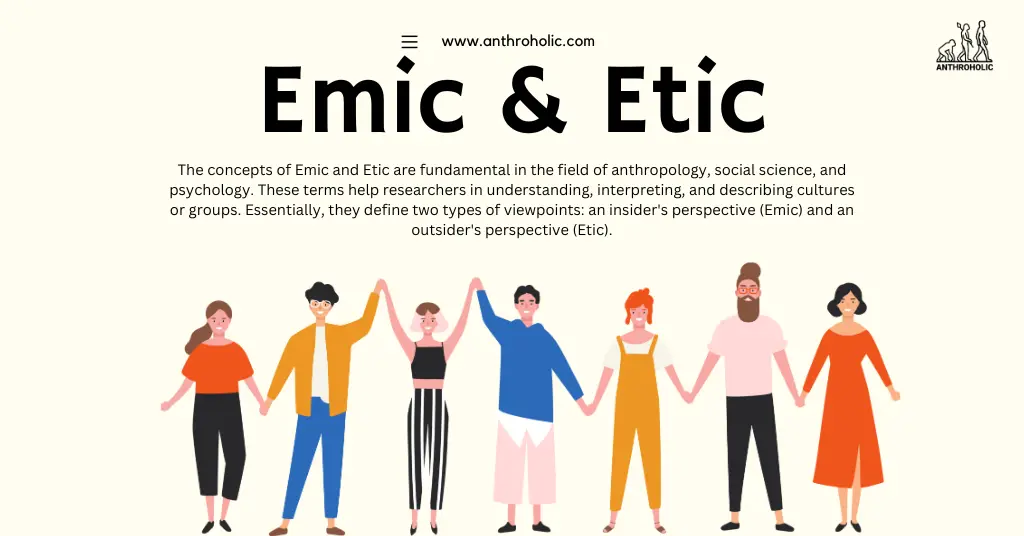AI Answer Evaluation Platform Live Now. Try Free Answer Evaluation Now
Emic and Etic
The concepts of Emic and Etic are fundamental in the field of anthropology, social science, and psychology. These terms help researchers in understanding, interpreting, and describing cultures or groups. Essentially, they define two types of viewpoints: an insider’s perspective (Emic) and an outsider’s perspective (Etic) [1].

The Emic Perspective
The Emic perspective refers to an insider’s view or interpretation of a culture. From this viewpoint, behavior is understood subjectively and contextually.
1. Features of the Emic Perspective
- Contextual Understanding: Emic viewpoint provides a detailed, rich, in-depth understanding of a particular group or culture.
- Subjectivity: Since it’s from the insider’s perspective, the emic approach is naturally subjective and deeply tied to personal beliefs, traditions, and customs.
- Participant Observation: The primary method of data collection in the emic approach is participant observation. Here, the researcher immerses themselves into the culture to gain firsthand experience and insights [2].
2. Limitations of the Emic Perspective
- Limited Generalizability: Because it focuses on one particular group or culture, findings from the emic approach may not be applicable to other cultures or societies.
- Potential for Bias: As researchers immerse themselves deeply into the culture, they may become biased, leading to skewed results [2].
The Etic Perspective
The Etic perspective represents the outsider’s view of a culture. It seeks objectivity and comparability across cultures.
1. Features of the Etic Perspective
- Objectivity: As an outsider’s perspective, the etic approach strives for a neutral standpoint, unaffected by personal biases.
- Comparability: Findings from the etic approach are often generalized, making them comparable across different cultures and societies.
- Standardized Data Collection: The etic approach often uses standardized methods of data collection, such as surveys and questionnaires, to ensure consistency [3].
2. Limitations of the Etic Perspective
- Lack of Contextual Understanding: By focusing on objectivity, the etic perspective may miss the nuanced, contextual details of the culture being studied.
- Risk of Ethnocentrism: There’s a risk that researchers may impose their cultural assumptions on the group being studied [3].
Emic vs. Etic: A Comparative Table
| Emic | Etic | |
|---|---|---|
| Perspective | Insider’s viewpoint | Outsider’s viewpoint |
| Focus | Contextual and subjective understanding | Objective and comparative analysis |
| Data Collection Method | Participant observation | Standardized methods like surveys |
| Potential Limitations | Limited generalizability, risk of bias | Missed contextual details, risk of ethnocentrism |
Emic and Etic: Complementing Each Other
Despite their differences, Emic and Etic perspectives are not mutually exclusive. In fact, combining both can result in a more comprehensive, balanced study. The Emic approach can provide in-depth, rich, subjective data about a culture, while the Etic perspective can provide objective, comparative data that can be generalized across cultures. Using both approaches allows for a thorough, nuanced understanding of the culture, while mitigating the limitations of each perspective [4].
Application of Emic and Etic Perspectives
Emic and Etic perspectives aren’t just theoretical concepts; they’re extensively used in a variety of research fields. Here are some key areas where they find application:
- Anthropology: Anthropologists often grapple with the Emic-Etic dichotomy while studying different cultures. While an Emic approach helps in gaining a deep understanding of a particular culture, the Etic approach enables comparison among various cultures [5].
- Psychology: In psychology, the Emic approach is often used in case studies, where an in-depth understanding of a person’s behavior is needed. Meanwhile, the Etic approach is frequently employed in survey-based studies, aiming to generalize findings across a larger population [6].
- Market Research: Market researchers employ both perspectives. They use the Emic approach to understand customer behavior within a specific market and the Etic approach to compare consumer trends across different markets [7].
- Linguistics: In linguistics, the Emic perspective helps understand language from the point of view of native speakers. The Etic perspective, on the other hand, aids in comparing different languages based on a common set of criteria [8].
Future Directions
The value of the Emic-Etic framework is increasingly recognized across disciplines, and its future application holds exciting possibilities. For example, in cross-cultural psychology, the use of the combined Emic-Etic approach could help to reconcile differences between cultures and create a more inclusive understanding of human behavior. In market research, an integrated approach could help companies better understand their customers and develop more culturally sensitive marketing strategies [9].
Table: Examples of Emic and Etic Application
| Field | Emic Application | Etic Application |
|---|---|---|
| Anthropology | Understanding a specific culture | Comparing various cultures |
| Psychology | In-depth case studies | Generalizing survey-based studies |
| Market Research | Understanding customer behavior within a specific market | Comparing consumer trends across different markets |
| Linguistics | Understanding language from the point of view of native speakers | Comparing different languages based on a common set of criteria |
Conclusion
In essence, the Emic and Etic perspectives represent two sides of the same coin, each providing unique insights into the study of human behavior and cultures. While the Emic approach offers rich, in-depth data from an insider’s perspective, the Etic approach provides a broad, comparative view from an outsider’s standpoint. Both perspectives are crucial, and when used together, they can enrich research findings, offering a more comprehensive view of the human experience.
References
[1] Morris, B., et al. (1999). Understanding and applying the concept of emic and etic in the study of personality and culture. Journal of Personality, 67, 947-978.
[2] Pike, K. L. (1967). Language in relation to a unified theory of the structure of human behavior. The Hague: Mouton.
[3] Headland, T. N., Pike, K. L., & Harris, M. (1990). Emics and etics: The insider/outsider debate. Newbury Park, CA: Sage Publications. https://doi.org/10.2307/541632
[4] Berry, J.W. (1989). Imposed etics–emics–derived etics: The operationalization of a compelling idea. International Journal of Psychology, 24, 721-735.
[5] Pike, K. L. (1954). Language in relation to a unified theory of the structure of human behavior. Glendale, CA: Summer Institute of Linguistics.
[6] Triandis, H. C., & Lambert, W. W. (Eds.). (1980). Handbook of cross-cultural psychology (Vol. 1). Boston: Allyn & Bacon.
[7] Douglas, S. P., & Craig, C. S. (2007). Collaborative and iterative translation: An alternative approach to back translation. Journal of International Marketing, 15(1), 30-43.
[8] Pike, K. L. (1967). Etic and emic standpoints for the description of behavior. In D. Hymes (Ed.), Language in culture and society (pp. 37-53). New York: Harper & Row.
[9] Berry, J.W. (1989). Imposed etics–emics–derived etics: The operationalization of a compelling idea. International Journal of Psychology, 24, 721-735.




